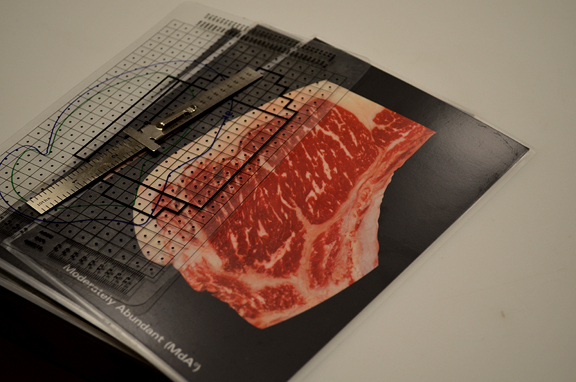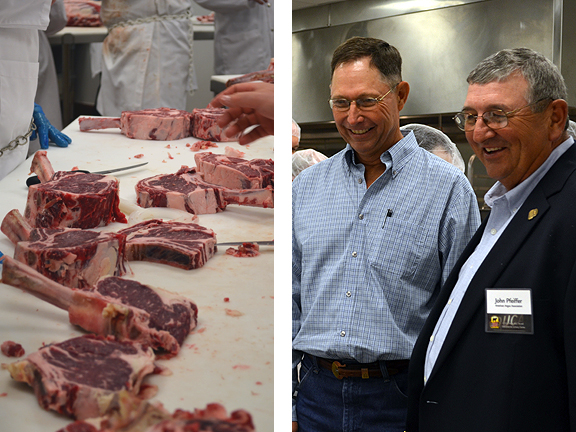Suiting up and slicing into a side of Angus beef … not something many of us have the opportunity to do often, if ever. But that’s what happened on a sunny Saturday in Wooster, Ohio. A group of 35 or so food and agricultural media gathered in the Certified Angus Beef ® Education and Culinary Center for a bit of meat fabricating 101.
Meat cutters wear frocks, vinyl gloves and a scabbard to hold knives — I knew that. What I learned, though, is that there’s a list of under armor as long as your arm that protects life and limb from super-sharp blades and meat saws. There’s a pair of cut-resistant gloves under the blue vinyl pair to protect digits. The white belly guard protects meat cutters from accidentally slicing into their own vital organs. They wear a cut-resistant sleeve to protect their arm.
Meat-cutting is risky business, truth be told. It’s also an art form perfected by years of experience. It’s an intricate, intensive study into the science of meat — and the brand’s team of experts shared some of that education with us.
They explained the finer points of the USDA beef grading system — highlighted by measurements and calculations and visual inspections. They talked about the Certified Angus Beef ® brand’s additional specifications and why abundant marbling is important.

Marbling is the key to truly flavorful beef. See all of those white flecks in the red beef above? That’s marbling … tiny flecks of fat. It melts during cooking and bastes the beef from within, enhancing flavors and ensuring each cut is tender and juicy.
Lesson learned: When shopping, look for steaks with lots of marbling. It’s a sure sign of premium quality (and incidentally, to earn the Certified Angus Beef ® brand label, Angus beef must have loads of marbling!). Avoid those pure-red cuts without white flecks. They’re lower quality grades of steaks — not so tasty, not so tender.

Hail to the beef!
You probably know people who are enthusiastic about their work. I’m guessing they might just pale in comparison to Dr. Phil. He LOVES beef. He THRIVES on cutting beef. He was a one-man whirlwind spreading his passion for primals throughout the room. And when he gets really excited, you’ll hear him exclaim, “HOLY COWS!” with great gusto while wielding what he refers to as his Texas butter knife.
Each participant had ample opportunity to do some meat-cutting. They were cheered on by table mates and instructed by a meat team leader. And you guessed it …
… you can’t have a whole mess o’ meatheads in a room without a little friendly competition. Which team cut the best steak? It was a tough decision, judged by Steve Olson of Hereford, Texas and John Pfeiffer of Mulhall, Okla. — Angus ranchers who watched the teaching, enjoyed the cutting, and delighted in choosing the best steak on the table.
What a team! Folks from all regions of the country — from varied publications, backgrounds and walks of life — participated in the process.
They followed the trail of a great steak (in reverse) … from dinner plate to farm gate with a beef cutting class in between. They ate well, laughed often and learned much. I’d say they earned an ‘A’ in meat-cutting 101.
How do you reward a bunch of hungry butchers?
We asked Chef Michael Ollier.
While we were cutting beef in the back of the house, he was cold-smoking and grilling Certified Angus Beef ® tri-tip for lunch. It was perfection on a plate.
Yesterday I shared the start of our journey — the Cleveland Dine Around. Follow along tomorrow as we visit Chippewa Valley Angus Farms and meet local folks who grow great Angus beef!








